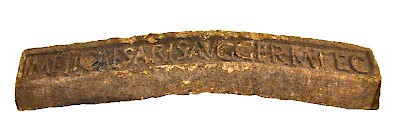Tongeren, lead bar

In May 2009, the Gallo-Roman museum in Tongeren, one of the best museums in the Low Countries, announced that it had acquired a lead bar that dated to the reign of the emperor Tiberius, 14-37 CE. The inscription, IMP TI CAESARIS AVG GERM TEC, is a bit puzzling, but the message is clear. The first words refer to Imperator Tiberius Caesar Augustus, the “tec” is mysterious but almost certainly refers to the mine, and the surprise is that this mine is in Germania. That means, at first sight, the east bank of the Rhine.
The problem is that most historians believe that Germania had been evacuated after the disaster in the Teutoburg Forest. This can be read in many ancient sources, like Tacitus‘ Annals, 2.88, where we read that the German commander Arminius was, “without any doubt the liberator of Germania”, or the Epitome of Florus, who believes that an expanding empire that had been able to cross the Channel had been halted at the Rhine (2.30). Although these authors wrote a century after the events and some seventy years after the creation of the limes, the decisiveness of the disaster in the Teutoburg Forest has always been axiomatic, and Roman finds on the Rhine’s east bank are automatically dated prior to the year 9. Perhaps the deepest cause is that Florus and Tacitus used to be popular school texts.
But was the disaster in the Teutoburg Forest decisive?
- In the first place, the oldest source, Velleius Paterculus, does not say that Germania was evacuated, and reports that fighting continued on the east bank, where the frontier roads were reopened (Roman History, 2.120). Although this is exaggerated and we do not know what limites meant exactly, it is unsound method to immediately assume that the only contemporary source contains an outright lie.
- In the second place, Tacitus explicitly says that the Roman base at Aliso remained in Roman hands and that forts were built along the Lippe (Annals, 2.7).
- In the third place, it seems that the goldmine on the Feldberg was never abandoned – although I may be wrong here; in any case, Geinsheim remained in use, proving Roman presence on the East Bank opposite Mainz.
- In the fourth place, there is some evidence, published by Rudolf Aßkamp, that Haltern was still in use after 9.
- In the fifth place, the Claudian army reforms appear to have been pretty important, and we know for a fact that Claudius has evacuated land beyond the Rhine – Tacitus’ Annals 11.19 follows on an account of a successful campaign against the Frisians, but this context does not exclude the possibility that a larger area was evacuated. In the Netherlands, this was the beginning of the creation of the limes; the first watchtower (Utrecht) is soundly dated in the forties.
I am not arguing that the Romans did never evacuate Germania; my point is that the date of the evacuation is very much open to debate. It may have been Claudius' decision, and I am not alone in my doubts. "Es ist falsch die Varusschlacht als historischen Wendepunkt aufzufassen, wie dies geschichtswissenschaftlich Unkundige gerade in diesen Tagen wiederholt propagieren," as P. Kehne summarizes in one of the splendid catalogs of last year's Teutoburg Forest expositions: "It is wrong to accept Varus' defeat as a historical pivotal moment, as people without sense of history are propagating these days".
This makes the Tongeren ingot quite sensational. Is this, again, evidence that the Romans were still in Germania? Were the Claudian army reforms the real pivotal moment? From the press release (9 May 2010), I get the impression that the museum has not completely realized the importance of this object. It writes that isotope analysis has shown that the lead could be from the Sauerland (Germania) and the Eifel (Gallia Belgica) and concludes that, since the Romans left the east bank in 9, we must assume that it is from the west bank. But this is assuming what needs to be proved!
I think that this lead bar deserves more study. In the first place, we may perhaps have a more precise isotope analysis. This, however, is not my specialty and perhaps this is impossible. In the second place, I'd like to know which sources prior to the Claudian army reforms call the west bank of the Rhine, which was indeed occupied by German immigrants, "Germania". To the best of my knowledge, Caesar, Varro, Strabo, and Velleius Paterculus consistently use names like Belgica, Celtica, or Gaul. If we find evidence that “Germania” could be used to describe the west bank, we must assume that the lead bar can be from both banks; if there is no such source, as I suspect, we may add the Tongeren lead bar to the evidence that the Romans did not evacuate the east bank prior to the Claudian army reforms.